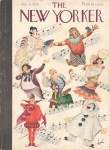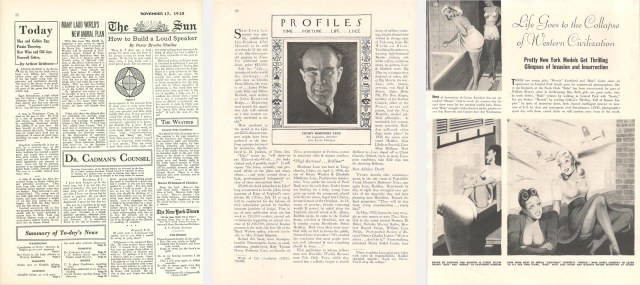Parody Of: Punch. Title: “Paunch.” In: The New Yorker, January 13, 1934, pp. 17-24. By: Thurber, Benchley, White, Irvin, etc. Availability: Sometimes findable on eBay, Abebooks, etc.; archived online at newyorker.com (subscription required).
“By humorous [art] we do not mean comic stuff, captioned by a wisecrack, no custard-pie slapstick stuff,” Harold Ross wrote potential contributors to the brand new New Yorker in 1925. “We want our things to be humorous from a sophisticated viewpoint. . . . We want to record the situations of everyday life among intelligent and substantial people as do the English magazines, notably Punch, except that our bent is more satirical, sharper.” How much sharper can be seen in the January 13, 1934, issue, which devoted eight pages to “Paunch,” The New Yorker’s longest and most elaborate parody of another publication.
And about the only. E.B. White created a double-page spoof of Manhattan newspaper features for the November 17, 1928, issue that looks like a collage of clippings from the originals. Just weeks before Pearl Harbor, Russell Maloney and Rea Irvin linked two of Time Inc.’s favorite subjects — cheesecake and catastrophe — in a black-humored, three-page “photo” essay called “Life Goes To The Collapse of Western Civilization” (Oct. 25, 1941). Otherwise, The New Yorker’s parodies — even Wolcott Gibbs’s famous Profile of Henry Luce in Time-style (“Time . . . Fortune . . . Life . . . Luce,” Nov. 28, 1936) — look like pages of The New Yorker.
“Paunch” appeared when the real Punch was at low ebb, a plight most critics blamed on Sir Owen Seaman, its editor from 1906 to 1932. Seaman’s morale-boosting during the First World War burnished Punch’s image, but he was a Victorian by temperament and no fan of the slangy, quick-witted, disrespectful and often absurd humor of the Roaring Twenties. “He did not see Punch as an organism or plan ahead, looking to see the way humor was changing, learning from successes and failures in the past,” R.G.G. Price says in A History of Punch (Collins, 1957). “He saw Punch as a National Institution and about as liable to change as the Nelson column. Its function was to act as a fixed point for a bemused public until a normal condition of stasis was resumed.” In practice, this meant freezing Punch’s cover in 1847, its layout in the 1860s and its prejudices in 1897 (the year Seaman joined the staff). Price, a longtime Punch insider, tries to accentuate the positive in his semi-official history, but his account of Seaman’s last decade is damning:
It is difficult now [1957] to realize the hysteria with which Punch was reviled in this period and beyond. . . . It was not even wholeheartedly on the side of reaction. It was tolerant, avuncular and patronizing. Criticism came from Right and Left, though every attack on class changes, Americanization of English speech, modern art or the modern girl was received with clucks of approval in hunting lodge and rectory and in the sad sitting rooms where daughters of military men gave music lessons. . . .
[Seaman’s] Punch has an air, at times, of providing jokes for those who found joking difficult. . . . The more one thinks about this policy the odder it seems. For a humorous periodical to be aimed at the unhumorous was as absurd as for a musical periodical to be aimed at the tone-deaf, but it is quite clear, by the tone of the correspondence from some of the older readers. . . that Seaman’s Punch did arouse a frenzied and deadly loyalty among bores, the naive and the prematurely old. [A History of Punch, p. 225-9]
Seaman reluctantly handed the editorship over to E.V. Lucas at the end of 1932, but “Evoi,” as he signed his Punch work, was no revolutionary. The Punch mocked in “Paunch” was essentially Seaman’s, and it showed all of its 93 years.

“Paunch” teased Punch’s obesessions with Hollywood films and gangland Chicago in “Charivaria;” James Thurber’s “Beast” and Franklin P. Adams’s “Caterpillar” mocked its prose and verse.
The New Yorker, on the other hand, was at the top of its game in 1934. Its circulation was around 125,000 and climbing, and in the six months from January through June it ran more ad pages than the Saturday Evening Post, which had led the field for decades. Its original rivals, Judge and the pre-Time Inc. Life, were dying, and Norman Anthony’s lowbrow Ballyhoo wasn’t in the same class. The New Yorker’s masthead featured — or would have featured, if it existed — James Thurber, Robert Benchley, Franklin P. Adams and Ring Lardner in addition to White, Gibbs and Irvin. All contributed to “Paunch,” infusing it with more A-list comic talent per square inch than any other parody in history. (Citation needed.)
The New Yorker didn’t trumpet “Paunch’s” authors at the time, but its online index says Thurber wrote “The Happier Beast,” a sendup of the cozy woolgathering that subbed for wit in too many “light” essays. Benchley downshifted his usual befuddled persona into complete ninnyhood for a featherweight dialogue called “Hyacinths for Pamela.” Gibbs, The New Yorker’s film critic, aped English insularity in “Mr. Paunch’s Cinema Review.” “The Mall,” by White, and “The Intent Caterpillar,” by Adams, nailed two of Punch’s favorite forms of bad verse: the sticky-sentimental and the mechanically clever. Uncredited newsbreaks and fake ads sent up Punch’s long-winded quips, its fixations on Chicago gangsters and Hollywood films, and — most hilariously — its tin-eared attempts at American slang. Though “Paunch” wasn’t promoted on the cover, the issue it ran in became the first in The New Yorker’s nine-year history to sell out on newsstands. (The second sellout contained Gibbs’s Time parody, which suggests a demand for such things.)
Irvin did most of the drawings, moving from elaborate crowquill to charcoal in the styles of Bernard Partridge, E.H. Shepard, George Belcher and others. The ringer is Thurber’s “Laocoon,” a spoof of Punch’s fondness for allegorical political cartoons based on classical myths. Nothing like Thurber’s doughy men and garden-hose snake would have appeared in the real Punch of the time, which may be the point: It’s a deliberate wrong note played outside Punch’s narrow range of “good” cartooning.
“Perhaps because of its nearness to the original, this parody was not received with much merriment in the Punch office,” R.E. Williams understates in A Century of Punch Cartoons (Simon & Schuster, 1954), “but when the magazine wholesalers phoned in to ask if they would be sued for libel if they handled the issue, the answer was a dignified negative.” Revenge came years later in the form of another parody, also eight pages, in the April 7, 1954, issue of Punch, called “The N*w Y*rk*r.” It sold out, too. — VCR







Pingback: A Poke At Punch – A New Yorker State of Mind